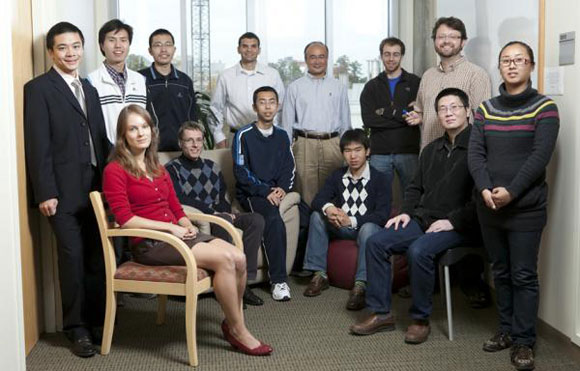
Weitao Yang (middle, back) and his research team.
For scientists who want to know how a particular molecule might behave in a given situation, or who want to design a molecule for a particular purpose, it’s essential to know how the electrons in that molecule behave. Enter Duke chemist Weitao Yang, who develops computational and theoretical methods that inform computer simulations of how electrons move and interact within molecules.
His methods have opened up opportunities for thousands of other scientists to address fundamental problems in chemistry and create new materials.
For his work, Yang received the Florida Award of the American Chemical Society in 2014. The award is given annually to recognize the leadership and professional contributions of a chemist in the southeast.
“Yang’s work is very innovative and has a large impact on what other scientists think about,” said Ernest Davidson, a chemistry professor at the University of Washington who nominated Yang for the award.
As a testament to the impact of Yang’s work, one of his papers was recently ranked number 7 on a list compiled by Nature of the most frequently cited research articles of all time and all fields.
“Chemistry deals with molecular structure and changes. Electrons play a very important role in that—electrons mediate the interactions," said Yang, the Philip Handler Professor of Chemistry and Physics. "My work is using physics and math to describe electrons. That relates to problems in chemistry, from very fundamental theories about electrons to practical approaches to solving certain problems.”
Simulating the behavior of every electron in a large molecule is not practical even with today’s computers. Several decades ago, scientists developed a strategy called density functional theory (DFT) as a way of describing the behavior of electron clouds, the locations around the nucleus where electrons are likely to be found. Yang has spent his career improving DFT to make it more useful.
“My theoretical contribution has two aspects,” he said. “Making the theory more accurate and making computational work more efficient.”
Making the theory more accurate is the subject of the seventh-most cited paper, which appeared in Physical Review B in 1988 and has been referenced more than 56,500 times since then. “It’s very useful,” Yang said of the technique described in the paper. “It’s a reasonably accurate theory and at a reasonable cost in terms of computer time to run the calculation.”
Yang wrote the paper with Chengteh Lee and Robert G. Parr, who was his adviser at the University of North Carolina, Chapel Hill, where he earned his PhD in 1986. After spending a post-doc year at the University of California, Berkeley, Yang joined the Duke faculty in 1989. Although Yang was born in Chaozhou, China, he now calls himself “almost a native North Carolinian” since he’s lived longer in North Carolina than any other place.
On the efficiency front, Yang invented a method commonly known as “divide-and-conquer” that makes it practical to simulate larger molecules. He said, “If you have a big molecule, you cut it into pieces, solve the pieces, then put them back together.” He described divide-and-conquer in a single-author paper in Physical Review Letters in 1991.
“That piece of work I’m really proud of,” he said. “It was when I was first at Duke getting my tenure. I was thinking a lot on the problem. One night, [the solution] came. I was working in the lab—I was single and I was in the lab all the time. I knew it was exciting. You have to convince yourself before you write the paper to convince other people. But I knew it was exciting.”
More recently, Yang and his students tackled an old problem with DFT related to its failure in systems where electron spins and charges are fractions rather than integers. “We revealed the origins of this failure, which led to the development of much improved approximations,” he said.
He and his students have also been working on methods that would describe how electrons respond when exposed to electromagnetic fields. “We’re developing the theory to make it do something the existing theory wasn’t able to do,” he said.
The goal of all of these computational and theoretical improvements is to describe with ever-increasing precision how electrons move within molecules and how those movements affect the function of a molecule. This knowledge in turn informs research related to producing fuel from solar energy, understanding enzymes and other catalysts, and designing new drugs.
“If you understand the structure and how it works, you have the chance to design something better,” said Yang.